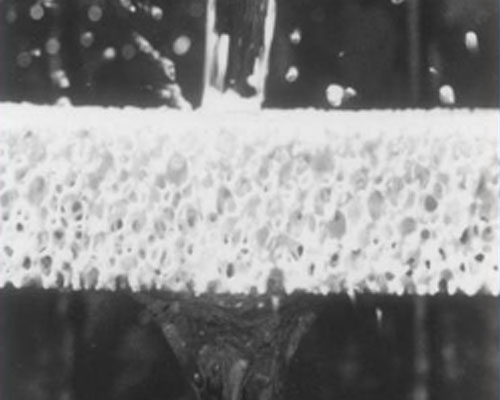Ceramic foam filtration mechanism is generally described as diffusion interception and inertial collision interception or screening, depositing layer and deep bed filtration. A Laboratory established a three-dimensional physical model and two phase flow model for the ceramic foam filtration mechanism, and carried out the simulation calculation, which is helpful for our research on filtration and purification of aluminum liquid. However, the filtration and purification process of aluminum foam by foam ceramics is very complicated, and is also a complex process of high temperature physical chemistry and metallurgical kinetics.
1. by sieving inertial filtering and intercepting, friction, settlement and other mechanical filtration, the filtration efficiency is directly proportional to the mesh size of the foam ceramic. The smaller the mesh, the stronger the interception ability of small particles.
2. With the deposition of particles in the melt and the uneven grid support walls, the trapping ability of heterogeneous particles is improved.
3. The rough surface formed by the gap on the surface of the scaffold increases the interface between the liquid aluminum flow and the ceramic solid surface, which makes the flow direction of the particles in the liquid aluminum flow more disordered, which is conducive to the capture and deposition of solid particles.
4. Due to the micro cracks and pinholes on the surface of the scaffold, fluoride fluxes with strong affinity to particles such as Al2O3 were pre deposited, which promoted the complete filter cake layer effect and strong chemical adsorption force, and enhanced the ability to capture the retained heterophase particles.
5. Moreover, from the effect of temperature field in melting process and transmission process of metal melt structure, the concentration bottom difference of alloy solute must be formed. The metal melt is redistributed, integrated, redistributed and integrated, which is also a good alloying process. Some high melting point metal phases and compounds regroup and grow up again, and the fine heterophase is beneficial to filter and capture. This can also be explained by the change of the concentration of H, Al2O3, Fe and Ti phases before and after filtration. In particular, double stage filtration or pore gradient thick plate filtration is more obvious. Therefore, under the same precondition, the new foam ceramic filter plate has a high removal rate of impurity phase in aluminum melt, and the change of static pressure difference before and after filtration is greater with time. The content of H in aluminum melt before and after filtration is also obvious. Of course, the smaller the choice of the foam ceramic hole, the greater the cleanliness of the molten aluminum.

AdTech is a professional alumina ceramic foam filter manufacturer. From material selection, pulping and mixing, carrier pretreatment, infrared drying and sputtering coating, microwave drying, and roasting temperature field effect control, we have studied a set of strict technology to complete the high temperature metallurgical physical and chemical process suitable for aluminum melt purification and effectively improve the cleanliness of aluminum melt.

